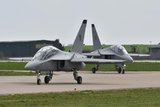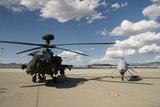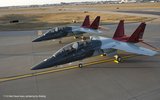I/ITSEC 2022: Putting the USAF Pilot Training Next effort to the test
US Air Force student pilots prepare for a T-6 training sortie. (Photo: US DoD)
At I/ITSEC 2022, under the banner of 'VR Training in the Wild Blue Yonder', Julia Brown of Aptima delivered a paper jointly written with the USAF's Air Education and Training Command (AETC) entitled ‘Pilot Training Transformation: Early Results and Lessons Learned’.
Pilot Training Transformation (PTT) has been under way for approaching four years and is designed to upgrade the current Undergraduate Pilot Training (UPT) programme with new curricula to move students through the air force’s training pipelines for the T-6, T-1 and T-38 aircraft streams faster and with more efficiency.
In many ways the USAF programme mirrors what the navy is doing with its Projects Avenger, Hellcat and Corsair.
Related Articles
Fireside Chat forum speakers stress need for training acceleration at I/ITSEC 2022
I/ITSEC 2022: How the US Marine Corps' future vision will impact the training & simulation industry
In essence PTT, with particular emphasis on its deliverable programme, Pilot Training Next v.2.5 (PTN 2.5) is all about student-centred learning through use of immersive training technologies that can be accessed at any time. According to AETC, this approach allows the student to move through the training pipeline faster.
But how fast? Speaking after the first PTN 2.5, or as the air force now refers to the course, UPT 2.5, Col Seth Graham, Commander 14th Flying Training Wing at Columbus AFB, explained: ‘One of the biggest changes for these students outwardly is that UPT used to be a 52-week programme and then you received your wings. These graduates are now receiving their wings in a six-month period.’
'UPT used to be a 52-week programme and then you received your wings. These graduates are now receiving their wings in a six-month period.’— Col Seth Graham, Commander 14th Flying Training Wing, USAF
The Brown/AETC trial randomly selected students to go through the standard UPT programme (UPT 2.0) or the UPT 2.5 curriculum and then tested them in a ‘Simulator Profile Assessment’. Nine metrics were used for the evaluation including mission planning, basic aircraft control, task management, ‘misprioritised tasks’, failed tasks and late tasks.
‘Overall, results demonstrate that the 2.5 curricula produced graduates of at least an equally high, if not higher calibre than the 2.0 curricula,’ concluded Brown.
The assessments were done over three phases, T-6, T-1 and T-38, and Brown found that, ‘advantages were particularly pronounced in the second phase of UPT, in the T-6’. For The T-1, students were ‘significantly timelier in their performance of tasks’ compared to UPT 2.0, while T-38 students, both 2.0 and 2.5 ‘performed at a similar level of performance.’
Shephard asked AETC’s Mark Hoelscher whether the USAF had liaised with the navy concerning their similar programmes. ‘Less than we should have but more than none,’ was his answer.
Shephard's I/ITSEC 2022 coverage is sponsored by:

More from I/ITSEC 2022 Show Portal
-
![I/ITSEC 2022: HII enhances human-machine teaming training for US Army]()
I/ITSEC 2022: HII enhances human-machine teaming training for US Army
HII’s crewed-uncrewed teaming training system has been tested with the US Army’s Apache, but it can operate with any autonomous system with the right equipment to receive data.
-
![All the news from I/ITSEC and talking seabed warfare]()
All the news from I/ITSEC and talking seabed warfare
The Shephard Media news team looks at all the developments in the military training and simulation world, and discovers the trends and challenges in seabed warfare.
-
![Leonardo explores 6th-generation combat aircraft simulation at I/ITSEC 2022]()
Leonardo explores 6th-generation combat aircraft simulation at I/ITSEC 2022
Leonardo is developing the Smart Chair system in its Battle Lab that allows for advanced pilot training for multi-domain scenarios and can potentially 'replicate a sixth-generation fighter jet cockpit'.
-
![I/ITSEC 2022: Red Hawk jet trainer to be digital platform from day one]()
I/ITSEC 2022: Red Hawk jet trainer to be digital platform from day one
Boeing's T-7A Red Hawk simulator and maintenance training system will allow pilots and ground crew to train in novel ways as soon as the platforms are delivered.
-
![I/ITSEC 2022: Saab stays focused and committed to multi-site training delivery]()
I/ITSEC 2022: Saab stays focused and committed to multi-site training delivery
Saab has increased training activities across core markets, opened combined training centres and is set to grow its business further.
-
![I/ITSEC 2022: CAE to create ‘data ecosystem’ in synthetic environment and rethink approach to innovation]()
I/ITSEC 2022: CAE to create ‘data ecosystem’ in synthetic environment and rethink approach to innovation
CAE believes the future of training technologies will be fundamentally driven by bringing different industries together and no single company can exist in a vacuum - an approach that defence should adopt too.
























